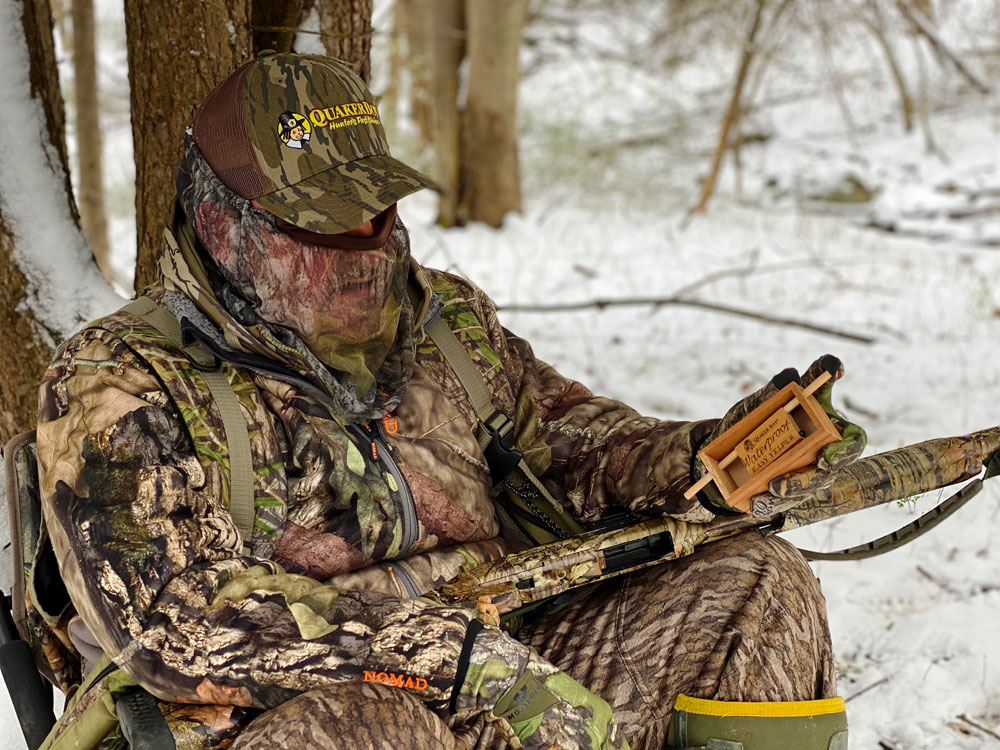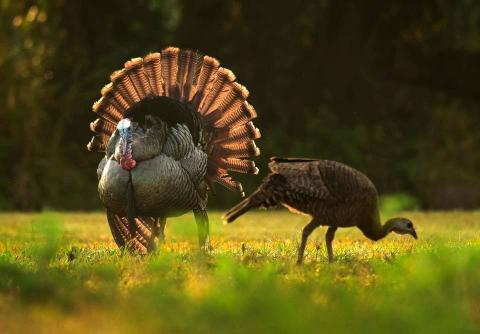provided by John E. Phillips
Mossy Oak ProStaffer Chris Kirby, the owner of Quaker Boy Calls in Springville, New York, started learning to call turkeys about the same time he learned to walk, because his dad was the late Dick Kirby, founder of Quaker Boy Calls, and one of the earliest individuals who helped to grow the sport of turkey hunting after the restocking of wild turkeys began in many states. Kirby has won the U.S. Open Turkey Calling Contest four times, the Masters Invitational Turkey Calling Championship twice, the World Turkey Calling Championship once and the Grand National Turkey Calling Contest, the largest, oldest, turkey-calling contest. He’s hunted all over the U.S. for turkeys. However, New York State homes plenty of farmlands, woodlands, mountainous terrain and cattle pastures - all ideal habitat for the wild turkey. That far north though, there’s plenty of snow during the winter months and occasionally in the spring. This April has seen large amounts of snow particularly across much of the Midwest.
Northern Turkey Hunting Explained
Occasionally, snow will fall at the first of turkey season. Our season in the Northeast generally starts at the first of May and ends on the last day of May. Sometimes, we’ll have snow the first week in May, although that’s a somewhat unusual occurrence. But no one who lives here is surprised when opening day of turkey season we look out the window, and there’s snow on the ground. I’m often asked, “What do the turkeys do when your area has snow at the first of the season?”
Well, turkeys are still going to be turkeys - regardless of whether snow is on the ground or not. The first day we have snow, the turkeys may not gobble much because when they open their eyes in the morning and see that white blanket of snow on the ground. But here in New York, we live in snow and cold weather for four or five months of the year, so seeing snow isn’t a really unusual sight for turkeys. It’s just a little unusual when snow occurs at the beginning of turkey breeding season.
The biggest change I make when we get a freak snowstorm in May is I slow everything about my hunting down some. By that, I mean I’ll go to an area where I know turkeys are holding. And, I set up - not thinking the turkeys will be as vocal or as active as normally at the first of the season. But, within two or three hours, the snow will begin to melt. Generally by lunch, all the snow will be gone. Instead of running and gunning, I have to realize that when I see snow on the ground that the first part of the morning I’ll have to exercise more patience than I usually will if snow isn’t on the ground. Then around lunchtime, I’ll be able to hunt more aggressively. Turkeys may stay in a tree longer after daylight when snow is on the ground than usual. And, generally they probably won’t gobble as much.
So, the first consideration I make on opening day is to determine the area where I’ve seen the most turkey sign on a western-facing slope that will warm up first early in the morning. Generally, but not always, when there’s a snow storm, the turkeys will roost on a hillside that the sun hits first thing in the morning that warms them and the ground up. I like to set up in the woods on the edge of a pasture or a hidden field. Then the turkeys can fly from the roost and start feeding either on cow manure or on grass and seeds that appear first after the snow is warmed up by the sun. Also, I’m conscious of the fact that turkeys have dark feathers. The sooner they can get sun on those dark feathers, the quicker they will warm-up. That is the kind of place I look for when I plan to hunt after a snow at the first of turkey season. I’ll give soft calls that I’ve been practicing before the season opens - soft clucks, purrs and really soft yelping.
I’m trying to match the mood of my calls to where the birds are and what they’re experiencing. For instance, if you’re camping out and sleeping in a tent, and a snowstorm hits at night, you won’t wake up first thing in the morning, jump out of your sleeping bag and act excited to see the snow. Neither will the turkeys. Also, someone in camp who’s talking loudly will irritate you. So, I want to give those soft calls to let the gobblers know, “This is where I am. I’m cold, I don’t want to talk much, but I’m right here.” As the day warms-up, and the snow starts melting, I may give somewhat louder and more aggressive calls every now and then. I don’t expect the birds to gobble as frequently as they will on a warm day.
Probably a gobbler will answer my calling, but he won’t call a lot, and he won’t come running in to the call. He’ll more than likely be moving kind of slowly like you will on a cold morning. I’ll need to stay on my stand longer than I will on a warm morning. And, I don’t want to move much - even when I do change locations. I’ll usually spend an hour or two on a stand after I’ve heard a turkey gobble to my call.
Other things to remember about hunting in inclement weather is that gobblers only have 30-40 days to breed hens. Regardless of the weather, they’ll be breeding hens in bad weather, snow, rain and/or cold temperatures. Of course, when there’s a blanket of snow, the turkeys are easier to see when they come to your calls. However, the hunters are seen easier by the turkeys too when snow is on the ground. I want to pick a hardwood or hemlock tree bigger than my shoulders to sit up against. Hemlock tree branches hang over more than the branches on hardwood trees will. The hemlock tree will give me a little more protection if more snow starts falling, or if the wind starts blowing, than a hardwood tree will.
As far as my camouflage, I don’t change to snow camo when we have snow that falls overnight. I’ll have on my Mossy Oak Obsession or Bottomland camouflage that I wear all season. I always carry a fold-out turkey chair that keeps me about 2 or 3 inches off the ground, and I point my left shoulder in the direction from which I expect the turkey to come. And, the real key to being able to sit longer and not move when turkey hunting is to pick a chair or cushion that is really comfy and keeps you from getting too cold.
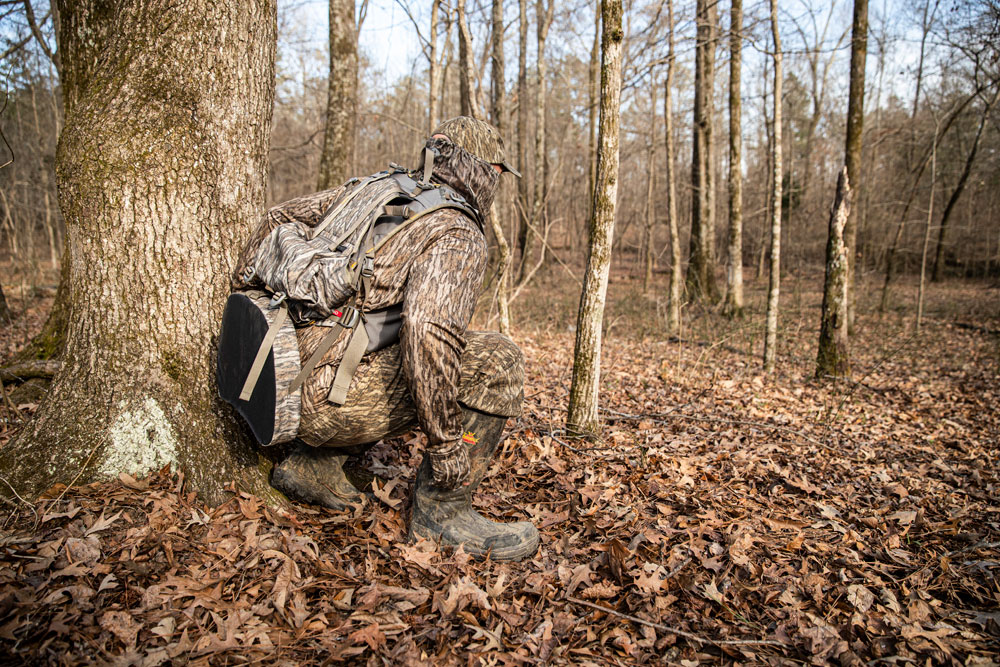
Shop Easy-Access Gear from Walmart: Men's Long Sleeve Obsession Hunting Performance Shirt
Northern Turkey Hunting Tactics
Where I live in upstate New York, we have numbers of hills and mountains and hunt differently than I hunt in places like Mississippi, Alabama and Texas where there’s a lot of flat ground. But, regardless of where I hunt turkeys in this country, the turkey food source is a primary consideration of where I’ll set up. If the turkeys are roosting on the side of a hill or on top of a hill, and a dairy cow pasture is on the bottom of the hill with plenty of cow manure in it, then more than likely, the turkeys will pitch down off that high ridge and land in that pasture with all that cow manure. Turkeys understand that a lot of undigested grain is in those cow patties, and they feed on that undigested grain in the cow manure.
My general rule when I’m setting up on turkeys is to be on the same level or above the turkey that I’m trying to call. When you’re set up above the turkey, you have a better sight picture (you probably can see the turkey coming to you before he spots you). I’ll set up on the same level as a turkey too, so he doesn’t have to walk uphill or downhill to reach me. Turkeys can walk easier on the side of a mountain than to walk up a mountain.
I believe that most often when a gobbler flies out of the tree, he’s looking for breakfast and wants to be in a place where he can see danger approaching, and where the hens can see him. He can feed until the hens reach him. So, the places that meet that criteria will be an opening in the woods or pastures or fields. I’ll set up just inside the wood lines of these types of openings. If I’m on the side of the hill looking down at the pasture, and I see the turkey fly down, and he answers my calling, then he knows where I am. But he’ll still probably spend an hour or two filling up his craw with grain, grass and insects before he has to make that hike up the side of the mountain to come to me. Or, if I know there’s an opening close to where the turkey is roosting, I may put a decoy in that opening before daylight, set up off to the side of that decoy and wait for the turkey to come out in the field to feed.
Another tactic I’ve used in the past is if I’m hunting a field or a pasture, and the gobbler shows up there, feeds, gobbles and struts, and the hens come to him, and the hens take him off away from me, then on the next morning, I’ll set up a portable ground blind in the pasture. I won’t plan to hunt out of it until the following morning. Setting up a blind in the middle of a field can be a very effective way to take a gobbler that meets his hens in that field, and the hens continuously take him away from you. If I’ve got a blind set up and a decoy set out, then when that ole bird comes to the pasture, I’ll have a very good chance of taking that tom when he first comes into the pasture.
Often, I’ll be in the bottom between two hills. I’ll assume that a turkey will be roosting in nearby big hardwoods. I’ll get there before daylight and try to set up to take that turkey when he flies down off the roost. However, if I hear a turkey gobble on a hill on either side of the bottom, I’ll have a hard decision to make. If that gobbler doesn’t fly down into the bottom where I can call him and be on the same level with him, then I may back out of the woods, circle around, get above the gobbler and try to call him up the hill to me. Often an old logging road will be on top of the hill where the turkey feeds and/or struts and meets his hens. However, if I don’t know what the turkey will do when he flies off the roost, I may just sit in the bottom and listen for the gobbler to leave the roost. Then I’ll attempt to determine in what direction he’s walking, move and get in front of him. I’ve found when you don’t know what to do when you hear a turkey gobble, or where you need to be to take him, the best option may be to let the turkey get on the ground first and start gobbling as he moves in the direction he’s walking that morning.
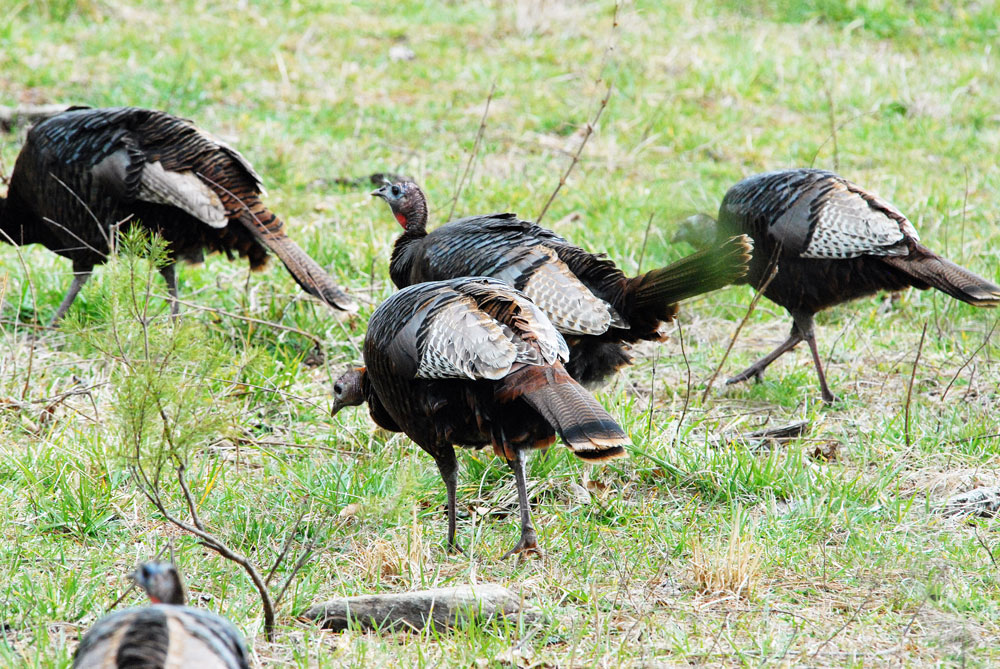
Chris Kirby Hunts a Tough Turkey He Still Hasn’t Taken
The toughest turkeys I have ever encountered are the turkeys I’ve never killed. Probably the most challenging turkey for a hunter to take is the tom that’s extremely vocal because when a turkey is gobbling from the roost and is gobbling a lot, he knows that the hens are supposed to come to him. He also realizes that predators are out there like coyotes, bobcats and others that can and will come to him. That turkey is smart enough to know to stay in that tree and continue to gobble until he sees the hens right under his tree. Then he knows that he has an army of eyes on the ground that will spot danger before he drops down out of that tree. These generally older, more mature gobblers have survived several years of hunting pressure and been able to dodge natural predators.
Another tough turkey is the turkey you hunt all season long. However, perhaps at the end of the season, he makes a mistake and gives you an opportunity to take him. Now these birds can be season killers. You may hunt him all season or even for two to three seasons and never take him. And, while you’re trying to take him, you may be able to take a dumber turkey instead of that ole bad bird. You probably have had that old gobbler almost close enough to take, and he’s gotten away from you several times. That’s why you keep going after that bad bird, but he continues to beat you. When you harvest one of these challenging turkeys, the reward is well worth the effort to try to harvest him.
I had a bird somewhat like that on a new piece of property that I’d just purchased. I pulled up in the woods before daylight, sat in my truck and heard him gobble. Then I heard a hen yelp about 100 yards from my truck, and the tom gobbled. Before I could step out of my truck and get my vest and my gun, that gobbler flew down and landed about 70 yards from my truck. The hen came to him, and they went on up the hill together. The next morning, I went to the same place, got out of my truck, the hen yelped, the gobbler flew to the road, and the hen took the gobbler up the road, over the hill and into a bottom. So, the next morning I went to the field and set up. And before long, the hen came down the hill into the bottom, but the gobbler wasn’t with her. Instead the gobbler circled the field and appeared 100 yards from the hen on the other side of the field.
About two or three weeks later, I decided to go after that tom and use a totally different approach than how I’d hunted him before. I knew where the gobbler was roosting. I got above him on the hill. Then I heard him walking about 25 yards behind me, and I saw him as I turned. But I couldn’t get a shot at him. And, I never did kill that turkey. However, I had so much fun during that season seeing that turkey from the truck, being out of the truck when the hen and gobbler got together, sitting on the field, getting above him with a new tactic and then hearing and seeing him that I felt like I’d had a successful season - even though that turkey won the day, and I didn’t. Will I go after him next year? You better believe it.
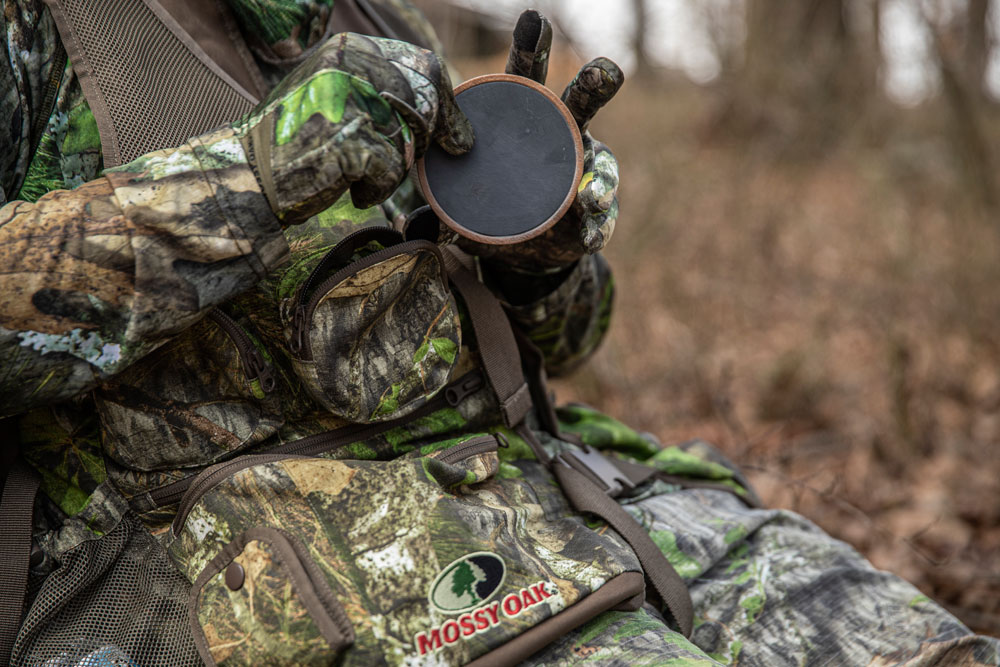
More Tough Turkeys Chris Kirby Has Hunted
I’m often asked, “If you have a good gobbling turkey and see him in the tree where he’s roosted, and he continues to gobble when he spots hens before he drops down in the middle of his hens and starts moving off, how do you take that turkey?” That’s one of the most frustrating situations that a turkey hunter can get into because you have to change tactics. You cannot call to a gobbler with a harem of hens, because they will see you before you see him. So, now that gobbler hunt becomes a hen hunt. You have to concentrate and think about what the boss hen is doing, where she’s going, and what she’s planning to do when she gets there. I’m fairly sure I may not get that gobbler away from that boss hen and the other hens travelling with the gobbler.
In that situation, I have to forget about calling to the gobbler and concentrate my calling on the boss hen. If you have only a limited amount of time that you can hunt turkeys, I try and get inside that hen’s head and determine if she’s going to water, if she’s going to food, and/or if she’s headed to cover. If I can see where she’s going, I can make a big circle, try not to be seen and hopefully make the boss hen bring the tom to me by calling aggressively to her and aggravating her. If she and the gobbler answer me, I’ll try and get her to come to me like I’m an intrusive hen attempting to steal her gobbler. That tactic may work. I also know that if I wait to hunt that turkey a week later, more than likely by then that boss hen and the other hens will have gone to their nests early in the morning. Then that gobbler will be looking for any hen he can find and will be much easier to call in than he has been the week earlier.
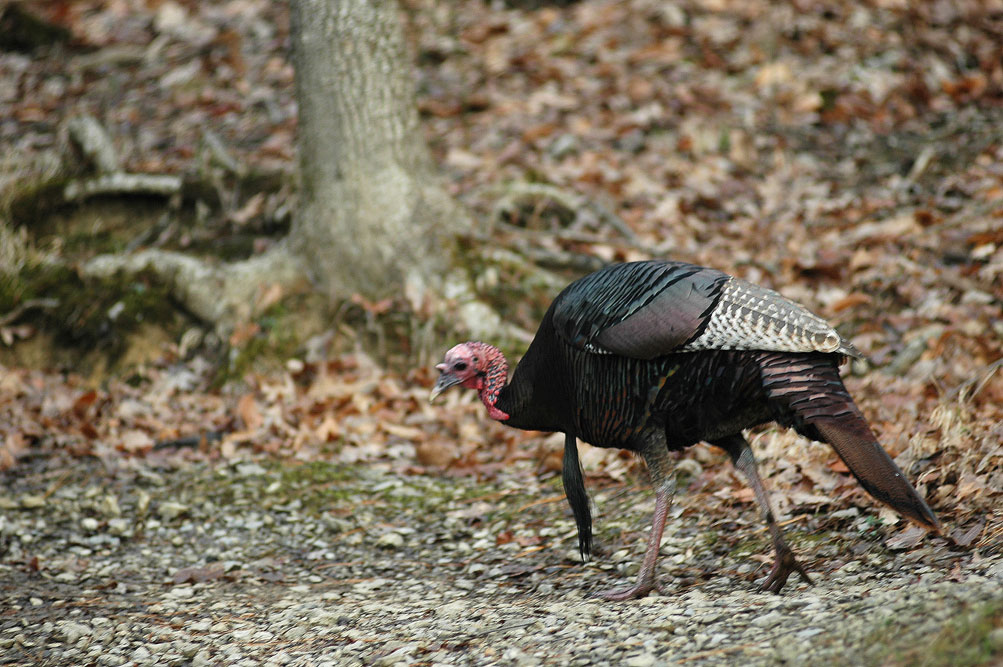
What to Do When You Can’t Make a Turkey Gobble
In seminars, I’m often asked, “What’d you do when you get into the woods, know there is supposed to be a gobbler there, don’t hear a gobbler or hens, sit quietly, and then call and nothing happens?” I thank God to start with that I’ve gotten to be in turkey woods that morning. Then I use my cell phone to call a buddy that I’m hunting with or know who’s hunting the same area I am, and I’ll ask him what’s happening where he is. If I know two or three more buddies are hunting on the property, I’ll call and ask them the same question, and if they’re not hearing or seeing any turkeys, I’ll assume that we have a mini-lockdown.
If you’re a deer hunter, you know there’s a certain time during hunting season that a buck that wants to breed with a doe won’t move much. He’ll be in thick cover for two or three days. When I’ve got information from my buddies about what’s happening where they are and determine the turkeys are on a mini-lockdown, then I go back to the scouting I’ve done before and during the season to remember where I’ve seen the most turkey sign all season. Or, I’ll remember where I’ve seen fresh turkey scratchings and the locations where turkeys can find the most food at this time of the season. I’ll go to those spots and plan to use every call in my turkey vest. I’ll spend an hour in each location - blind calling and just hoping a turkey will hear me, and that the gobbler will decide there’s one more hen he needs to breed before the day is over. And, I expect that gobbler to come in silent or only be drumming and strutting. I don’t anticipate hearing that gobbler before I see him.
This mini-lockdown usually takes place toward the end of the season when all the gobblers have been called to, shot at and missed and spooked off. So, that tom knows better than to gobble. If what he’s hearing is really a hen, he expects to see her or hear her. Remember that toward the end of the season in New York, the gobblers can’t see or hear as well as they have in the early season when the leaves are off the trees and bushes. So, if that turkey comes to you, he’ll be really wary and using all his defenses to make sure it’s not a goofy hunter just trying to kill him.
So, I start paying close attention to the little sounds in the woods that will alert me to a gobbler approaching. Do I hear a squirrel running through the leaves, going up a tree and possibly beginning to bark? I’ll listen for a blue jay to start squawking. I’ll attempt to hear a turkey walking in the leaves. I’m keenly aware of a gobbler’s spitting and drumming. You have to be on full alert at this time of the year and use all your senses to try and determine if a gobbler is close to you and not gobbling - if you’re going to take him. And, you can take a gobbler if you’re really lucky and pay close attention to every sound you hear.

